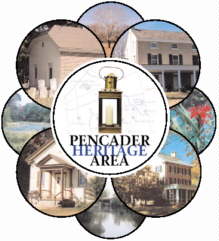 The attempt to build a feeder canal to supply water to the proposed Chesapeake and Delaware Canal in 1804 is a relatively unknown chapter in early American civil engineering. Benjamin Henry Latrobe was the engineer and architect in charge of the ill-fated
project that was designed to be a navigable canal about five and one- half miles long. It was to begin at the Upper Forge on the Elk
River in Maryland and intersect with the main line of the canal west of Glasgow, Delaware, where a holding reservoir would aid
in providing water in the dry seasons. With a planned width of twenty-one feet and a water depth of three and one-half feet,
shallow draft barges would be able to use the feeder to transport goods from Lancaster and Chester Counties in Pennsylvania to the
main canal.
The attempt to build a feeder canal to supply water to the proposed Chesapeake and Delaware Canal in 1804 is a relatively unknown chapter in early American civil engineering. Benjamin Henry Latrobe was the engineer and architect in charge of the ill-fated
project that was designed to be a navigable canal about five and one- half miles long. It was to begin at the Upper Forge on the Elk
River in Maryland and intersect with the main line of the canal west of Glasgow, Delaware, where a holding reservoir would aid
in providing water in the dry seasons. With a planned width of twenty-one feet and a water depth of three and one-half feet,
shallow draft barges would be able to use the feeder to transport goods from Lancaster and Chester Counties in Pennsylvania to the
main canal.
After years of surveys taken by several different experts, The Chesapeake and Delaware Canal Company was chartered in 1801. The idea of a canal crossing the peninsula was not universally popular and it was spring of 1803 before enough shares were sold to actually form the company. There then followed a great deal of bickering among the members of the board of directors, each one desiring to make a profit by having the canal run through his property or near his place of business. Finally, a route from Welsh Point, Maryland to Christiana Creek in Delaware was chosen. During this period Benjamin Latrobe bought property on Iron Hill
where he and his family lived for a short time. He also speculated on the future prosperity of the region surrounding the feeder canal by secretly purchasing land in Glasgow with Judge Kensey Johns.
In May 1804, work began on the feeder canal. The route Latrobe had laid out required water from the feeder in order to keep the
summit level filled. If the main canal had been finished first, it would not have been navigable until the feeder was completed.
No contracts had been made for equipment or supplies so Latrobe assumed the task of choosing the best craftsmen he could find to compose his workforce. Contractors who were assigned sections of a few hundred yards at a time performed the actual construction of the feeder with crews of up to 80 men each, usually composed of Irish immigrants which sometimes made life exciting. (Latrobe's letters describe a minor riot in nearby Elkton, Maryland between the Irish workers and the locals over horse racing.) Skilled carpenters made everything needed, from wheelbarrows to ladders and trestles necessary for excavation, while a resident blacksmith repaired the tools.
Thomas Vickers was one of the most important craftsmen working with Latrobe. He was familiar with a product new to this
country'hydraulic cement that would harden under water. His skills as a mason were needed to build the culverts, locks, bridges
and an aqueduct designed for the feeder canal. Three of his culverts may still be standing and if so, they may be the earliest surviving
examples of the use of hydraulic cement in the United States.
With all the skilled help assembled and ready to work, the deciding factor against the completion of the project turned out to
be lack of funds. By November 1805, the Canal Company was out of money and the project, with many sections completed, was
abandoned. Latrobe, who had been unable to collect any wages for months, finally left the company in 1806. The feeder was never
finished, but the sections that were completed were so well constructed that they are still in evidence today. When work
commenced on the Chesapeake and Delaware Canal in later years a different route was chosen and the feeder was unnecessary. The once rural area of the first engineering efforts to connect Bay and River is experiencing rapid development and hopefully steps will be taken to preserve a section of this early engineering feat.
|
